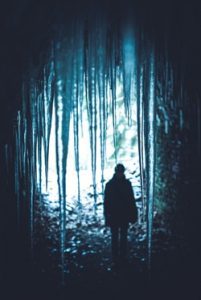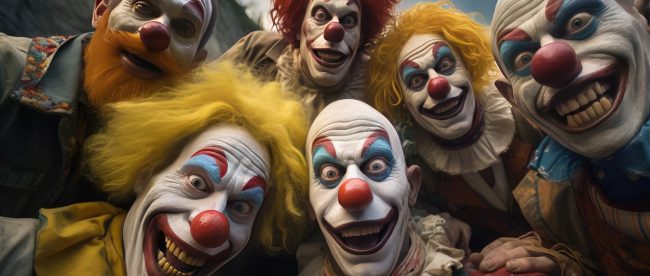Some of us love the scare, but why do we enjoy fear?
Fear alerts us to danger. It’s what makes us check if we’re truly alone at night. Being afraid is uncomfortable, yet it can be surprisingly thrilling.
By definition, fear should be an unpleasant experience. It is our body’s natural response to danger, and it works to keep us safe through vigilance and distress. But many of us find ourselves deliberately engaging with stuff that scares us – and loving it. So why do we enjoy fear?
From horror movies to rollercoasters to unsettling Halloween décor, why do we indulge ourselves in things that create fear?
Our body’s reaction
Our minds register perceived threats through a part of the brain known as the amygdala. The amygdala tells our body it needs to prepare for danger, causing us to enter the so-called fight, flight or freeze response.
In this state, our bodies produce increased levels of adrenaline to either fight off or escape from whatever is making us scared. This adrenaline spike causes the classic physical signs of fear, such as sweating, shaking and an elevated heart rate. And once the rush is over, we’re often left feeling exhausted.
Read more: why feeling a sense of awe is good for you
The feeling of fear
Nearly everyone experiences this impulse of fight, flight, or freeze in response to fear. What varies from person to person is how we react after the feeling of fear kicks in.
Screaming, laughter and crying are among the many ways people react to fear
According to Helen Reade, a positive psychologist, the way we react to fear is personalised to our lived experiences. If we associate horror with spending time with friends, for example, we’ll have more positive reactions to stimuli such as happiness or excitement. This can explain why scary things or situations cause drastically different responses in different people. Screaming, laughter and crying are among the many ways people react to fear.
For some, being afraid is a genuinely fun experience. It all comes down to how our brains react to a scary situation. Not every perceived threat elicits a fight-or-flight response from us – our brains are smart enough to recognise that something scary in a movie can’t hurt us, for example. After the amygdala recognises a threat, our hippocampus and prefrontal cortex work together to ascertain whether or not the threat is real or imagined. If we know it’s imagined, it’s generally much easier to sit back and enjoy the ride.
Can you learn to like being scared?
 This depends on what kind of fear is at play. Some causes of fear, such as trauma or genuine phobias, can make enjoying fear much harder or even impossible.
This depends on what kind of fear is at play. Some causes of fear, such as trauma or genuine phobias, can make enjoying fear much harder or even impossible.
If you’re able, and you want to build up that horror movie immunity, it comes down to two simple things: safety and control.
A big reason why some people love to be scared and others hate it is our risk assessments of scary situations. Take skydiving as an example. Those who often take the leap are familiar with the risks and safety of the situation – the pros and cons. They can then weigh these up in their minds more quickly and easily than someone who has never skydived.
The same is true of horror movies. If you watch tons of scary movies, you’re more used to the fact that nothing from them is real – after all, none of the monsters have ever actually come after you. This makes you more capable of enjoying the movie than someone who barely watches horror and is likely to be more on edge if you whip out the old Freddy Kruger videos.
To enjoy fear, do you just need to scare yourself more?
The short answer is kind-of! There’s a method, known as flooding, which helps your brain to reassociate scary stuff with safety. Reade explains this as a way to move past potential panic in a safe space. To keep with the horror movie example, you can ‘flood’ yourself by watching a bunch of horror movies from somewhere safe, maybe curled up on your sofa while hiding behind a pillow.
…it’s all about your mind’s associations with the source of fear… this is what decides your relationship with fear.
By linking the scares with a safe place, your mind can slowly begin to understand that you have nothing to fear. You may then be able to start reassociating this kind of fear with more positive things.
This means you can engage in enough scary stuff so that you grow to like it – it’s all about your mind’s associations with the source of fear. Does your mind associate a rollercoaster with a fun thrill or with uncontrollable speeds? This is what decides your relationship with fear.
Still not a fan of scary? Why not try something a little more zen
Not so scary now? Some readers want to improve their scare tolerance, while others just want to finally understand what thrill-seekers are on about.
Regardless, keeping ideas of safety and control in your mind can help you better manage your response to fear – at least recreationally. So whether you plan on trying out flooding, or you are just taking pointers for your next Halloween movie night, remember that your relationship with fear is yours to control. Why not take fear by the horns and see where it takes you?

Aiden is an editorial and production intern at Title Media whilst also studying for their English master’s degree. He’s constantly looking for opportunities to have fun and get creative, whether it be art, baking, storytelling… you name it!



Leave a comment